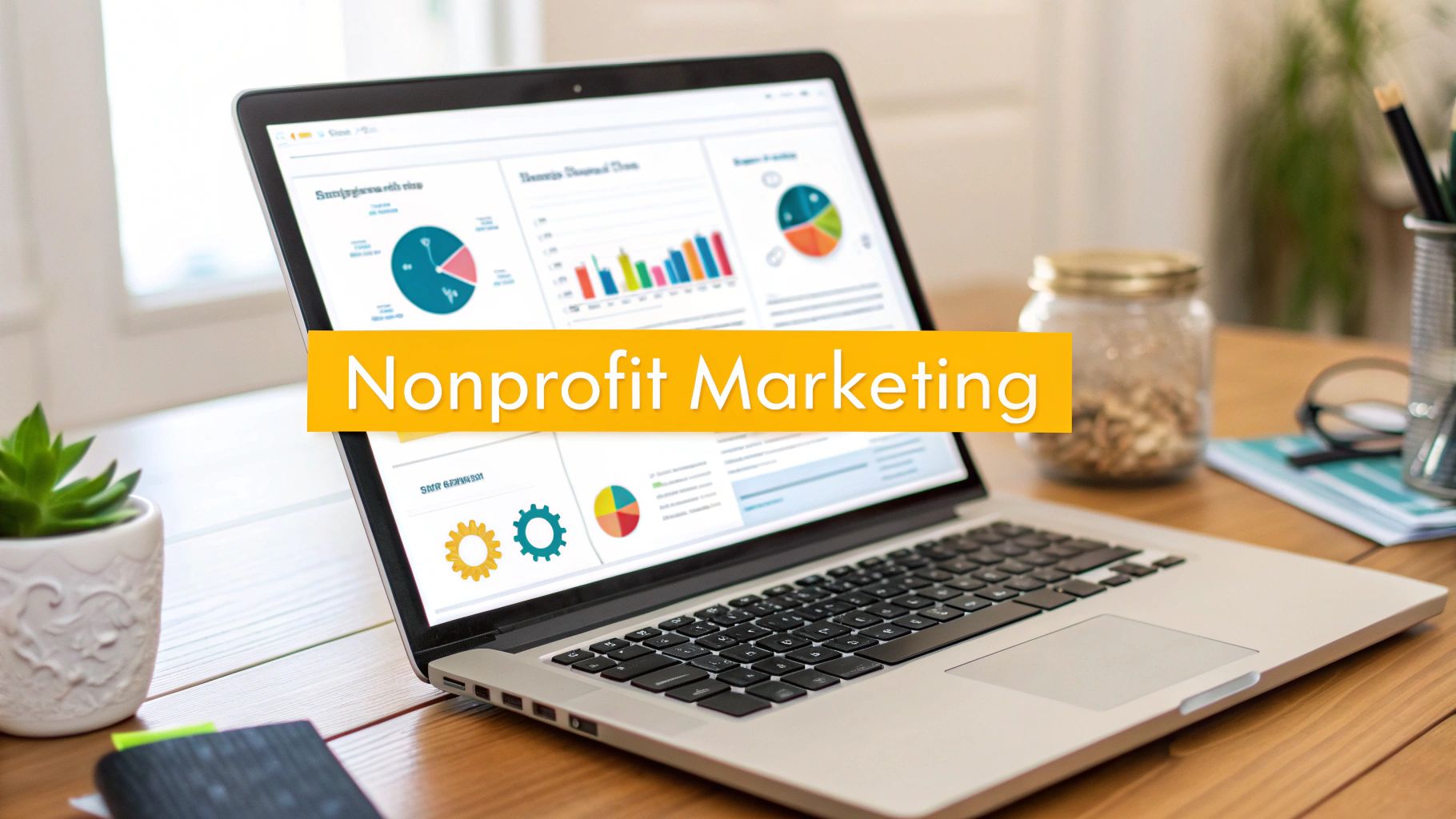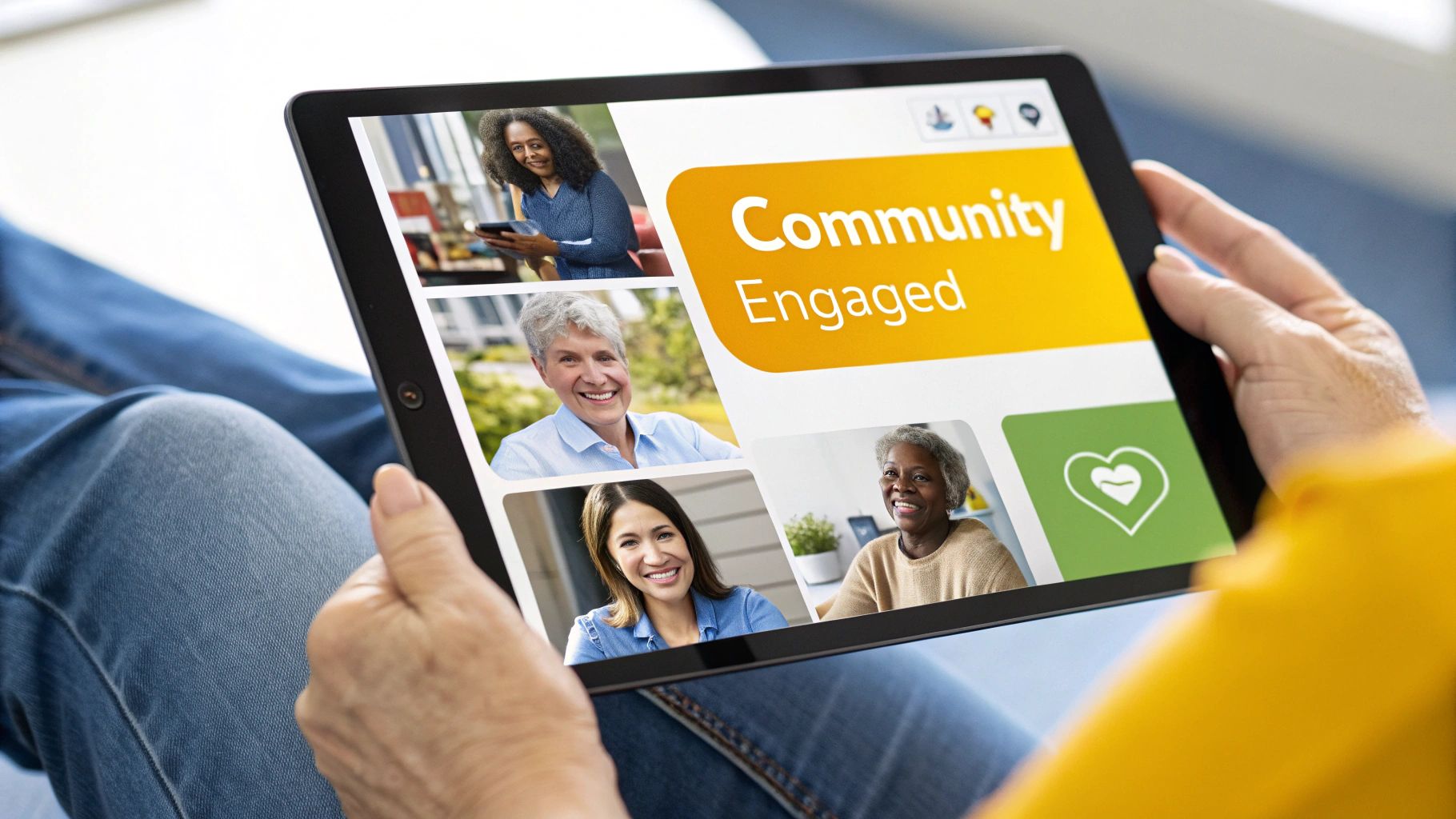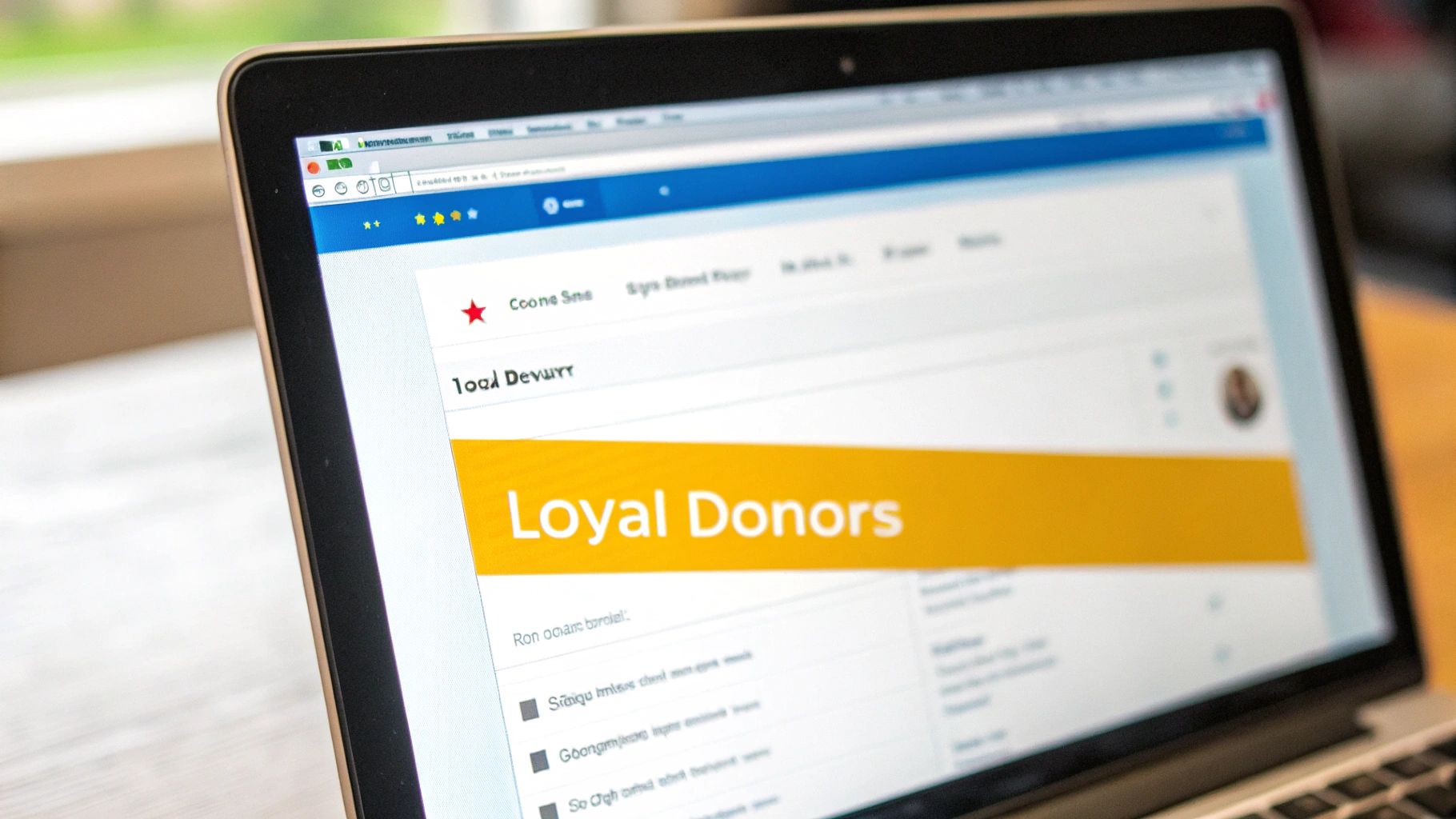Digital Marketing for Nonprofits A Complete Guide

When we talk about digital marketing for nonprofits, we're really talking about using the tools of the internet—email, social media, search engines—to build a community, raise money, and get the word out about your mission. It’s so much more than just sending out information. The goal is to start a real two-way conversation that rallies people around your cause. A smart digital strategy is what keeps a modern nonprofit running.
Why Digital Marketing Is a Game Changer for Nonprofits

In the past, nonprofits had to rely on one-way communication, like sending out mailers or hoping a press release got picked up. Digital marketing completely flips that script. It turns a monologue into a lively, continuous dialogue with your supporters. It’s the difference between tacking a flyer to a community bulletin board and hosting an open-house where you can actually talk to people.
This isn't just a small tweak; it's a fundamental change in how nonprofits operate. You're no longer just asking for a check. You're inviting people to be a genuine part of your journey. An active, transparent online presence builds incredible trust, showing donors exactly how their contribution makes a tangible difference. When people can see the impact, share the stories, and talk with your team, they stop being just donors and become your most passionate advocates.
The Growing Importance of Online Fundraising
This shift to digital isn't just about feeling connected—it's about keeping the lights on. Online fundraising has become a lifeline, especially for smaller nonprofits who can often be quicker on their feet with digital campaigns. Recent numbers show that for small nonprofits, online donations now make up 13.4% of their total revenue. That's a huge slice of the pie, and it shows just how much opportunity is waiting online. If you're curious, you can explore more fundraising statistics for nonprofits to see the full picture.
This growing reliance on online giving means every single piece of your digital presence matters. Every email, every social media post, and every website update is a step in a supporter's journey with your organization.
A successful digital strategy is the connective tissue that links your mission to your community. It’s how you find new supporters, nurture existing relationships, and create a sustainable framework for growth and impact.
Core Pillars of Nonprofit Digital Marketing
To make this all a bit more concrete, let's break down the essential channels. These pillars are the foundation of a strong digital presence, working together to attract and keep supporters engaged.
Here's a quick look at how the main channels fit together:
Core Pillars of Nonprofit Digital Marketing
| Channel | Primary Goal | Key Benefit |
|---|---|---|
| Email Marketing | Nurture relationships | A direct, personal line to your most committed supporters. |
| Social Media | Build community | Share real-time updates and visually showcase your impact. |
| SEO | Increase visibility | Helps people who are actively searching for your cause find you. |
| PPC (Google Ad Grants) | Drive targeted traffic | Reach a specific audience quickly with free advertising credits. |
| Content Creation | Educate and engage | The stories, videos, and reports that fuel all other channels. |
As you can see, each channel has a specific job to do, but they're most powerful when they work in concert. A great blog post (content) can be shared on social media, promoted through an email newsletter, and discovered by new supporters through a Google search (SEO). It's all connected.
Building a Loyal Donor Base with Email Marketing

While social media grabs a lot of headlines, email is still the undisputed champion for building deep, lasting relationships with your supporters. It helps to think of it this way: social media is the public square where you can rally a crowd, but your email inbox is where you have a personal, one-on-one conversation that turns a casual follower into a true advocate. It's your direct line to the people who have already raised their hand and said, "I care about your work."
This is precisely why email remains a cornerstone for nonprofit marketing. In fact, a staggering 86% of nonprofits around the world use email to connect with their communities. On average, they send about 62 emails per subscriber annually. The nonprofits seeing the most success know that personalization is everything—63% tailor their content to make each donor feel uniquely valued. You can dig deeper into these trends from Amra & Elma to see the full picture.
When you treat email this way, your list stops being a simple broadcast tool and becomes a powerful engine for building genuine connections to your cause.
From First Contact to Lifelong Supporter
The journey with a new supporter starts the second they hit "subscribe." A generic confirmation email is a massive missed opportunity. Instead, think about creating an automated welcome email series that acts as a guided tour of your mission. This sequence can introduce new subscribers to your work, share an unforgettable impact story, and set the tone for what they can expect from you.
Here’s a simple but incredibly effective structure for a welcome series:
- Email 1 (Sent Immediately): Send a warm welcome and a sincere thank you. Reassure them they made a great decision and maybe share a short, inspiring video about your mission.
- Email 2 (2 Days Later): Shine a light on the problem you exist to solve. Use a mix of data and personal stories to create an emotional connection and a sense of urgency.
- Email 3 (4 Days Later): Now, introduce the solution. Explain exactly how your organization tackles that problem and show the tangible results of your programs.
- Email 4 (7 Days Later): Time for a soft "ask." Invite them to get more involved by following you on social media or signing a petition—something other than just donating.
By building this foundation of trust and understanding first, any future fundraising appeals feel earned and natural, not sudden or transactional.
The Power of Audience Segmentation
Sending the same email to every single person on your list is like giving the exact same speech to a first-time visitor and your closest friend. It just doesn't work. To build real relationships, you have to talk to people based on their unique connection to your organization. This is where audience segmentation comes in.
Segmentation is what allows you to move beyond generic updates and deliver messages that actually resonate. It’s the difference between shouting into a crowd and having a meaningful, targeted conversation.
By grouping your subscribers into different buckets, you can tailor your messaging to be far more effective. Think about creating distinct segments for people like:
- New Subscribers: These folks are just getting to know you. Nurture them with that welcome series we just talked about.
- One-Time Donors: Thank them for their specific gift and show them the direct impact it had. This is your chance to encourage them to become a recurring giver.
- Recurring Donors: Treat these supporters like the VIPs they are. Give them exclusive updates, early access to reports, and heartfelt thanks for their ongoing commitment.
- Dedicated Volunteers: Don't forget their gift of time! Share volunteer-specific opportunities, celebrate their contributions publicly, and make them feel like a core part of the team.
When each group receives content that’s relevant to their experience, they feel seen and appreciated. That personal touch is what builds unshakable loyalty and inspires people to deepen their commitment over time.
Choosing the Right Social Media Channels to Amplify Your Mission

Jumping into social media can feel like trying to have a meaningful conversation in a dozen crowded rooms at once. With so many platforms clamoring for your attention, the biggest mistake a nonprofit can make is trying to be everywhere. It’s a fast track to stretching your team too thin, diluting your message, and burning out before you see any real results.
The secret isn’t a wider presence; it’s a deeper one. Instead of scattering your energy across every trending app, focus on the few channels where your people—your donors, volunteers, and advocates—are already spending their time. Think of each platform as a unique community gathering. You wouldn't throw a formal fundraising gala at a skatepark, right? The same logic applies here.
Aligning Platforms with Your Primary Goals
Before you draft a single post, hit pause. Ask yourself, "What are we really trying to do here?" Your core objectives should be the compass that guides your platform choices. Are you recruiting volunteers, driving donations, or raising awareness for a critical issue?
Each social network has its own vibe and user base, making it a natural fit for certain goals.
Facebook for Community Building: With powerful tools like Events and Groups, Facebook is tailor-made for rallying local volunteers and promoting fundraising events. Its massive demographic reach makes it a solid bet for connecting with everyone from young families to established, long-term donors.
Instagram for Visual Storytelling: If your mission comes to life through powerful images and video, Instagram is your stage. It's the perfect place to show the real-world impact of your work, share behind-the-scenes moments with your team, and connect with a younger audience that craves authenticity.
LinkedIn for Corporate Partnerships: Think of LinkedIn as your digital handshake with the business world. Use it to find potential corporate sponsors, recruit highly skilled board members, and share content that cements your organization's credibility in your sector.
X (formerly Twitter) for Advocacy and News: For nonprofits on the front lines of policy change and breaking news, X is essential. It lets you jump into real-time conversations, speak directly to journalists and policymakers, and mobilize your supporters around urgent calls to action.
Beyond Popularity—Look at Performance
It's easy to get mesmerized by huge user numbers, but they don't paint the whole picture. A platform's real value for your nonprofit often comes down to its fundraising effectiveness.
For example, TikTok has a staggering 1.12 billion users, but only around 15-27% of nonprofits are active there. Why? A big reason is the high cost per lead ($17.40) and a painfully low return on ad spend—just $0.03 for every dollar spent.
On the other hand, Meta platforms like Facebook and Instagram offer a much more sustainable average cost per lead ($3.20) and a significantly healthier return on ad spend ($0.48). This data is a clear reminder that your platform choice has to be tied to your financial goals.
Choosing a social media platform is less about its total number of users and more about finding the highest concentration of your users. Focus on the platforms that offer the most direct and cost-effective path to achieving your specific mission goals.
To help you decide where to invest your time and resources, here's a quick comparison of the major players.
Social Media Platform Comparison for Nonprofits
| Platform | Best For | Audience Demographic | Fundraising Effectiveness |
|---|---|---|---|
| Community building, event promotion, broad outreach | Wide range, particularly strong with Gen X & Boomers | Excellent, with built-in donation tools and strong ad ROI | |
| Visual storytelling, brand awareness, youth engagement | Primarily Millennials & Gen Z | Good, especially through Stories stickers and influencer campaigns | |
| Corporate partnerships, professional networking, recruiting | Professionals, B2B audiences, educated adults | Moderate; best for high-value corporate giving, not mass donations | |
| X (Twitter) | Real-time advocacy, news updates, public relations | Journalists, policymakers, engaged activists | Low for direct donations; high for awareness-driven campaigns |
This table gives you a starting point, but remember to test what works for your unique audience and mission.
Creating Platform-Specific Content That Resonates
Once you've picked your channels, avoid the temptation to just copy and paste the same message everywhere. That’s a surefire way to get ignored. The tips in these 7 Social Media Best Practices for Churches are incredibly helpful for any mission-driven organization looking to connect authentically.
A polished, data-heavy report that kills it on LinkedIn will feel out of place on Instagram, which thrives on candid, emotional visuals. Similarly, a fast-paced, funny video made for TikTok requires a totally different tone than a detailed event announcement on Facebook. If you need some inspiration, we've put together a guide filled with practical social media content ideas.
By respecting each platform's culture and creating content that feels like it belongs there, your message won't just be seen—it will be felt. And that's what inspires people to act.
Making Your Cause Discoverable with SEO and Content

Think of your website as a powerful book detailing your mission, your impact, and your stories. So, what’s Search Engine Optimization (SEO)? It's the process of getting that book perfectly cataloged in the world’s biggest library: Google.
Without smart SEO, even the most moving stories get lost on a dusty digital shelf. It’s all about helping people who are already looking for a cause just like yours to find you. When someone types "animal shelters near me" or "how to support clean water initiatives" into that search bar, you want to be right there on the first page. SEO is what builds that bridge.
Understanding Keywords: The Language of Your Supporters
The bedrock of good SEO is figuring out the exact words and phrases your potential supporters are using. We call these keywords, and they are the key to unlocking your audience. Think of them less as technical terms and more as the questions your community is asking. Your content’s job is to provide the answer.
Don't just guess. You can use free tools like Google Keyword Planner to see what people are actually searching for. You might be surprised to learn that while you call your program a "youth mentorship initiative," the community is searching for "after-school programs for teens." Speaking their language is the first, most critical step to showing up where they’re looking.
You'll want to uncover a mix of keywords:
- Informational Keywords: Phrases like "what is food insecurity?" that attract people who are just starting to learn about your cause.
- Navigational Keywords: This is simply your nonprofit’s name—for people who already know you and want to find you quickly.
- Transactional Keywords: These are high-intent phrases that signal someone is ready to act, like "donate to environmental charity" or "volunteer at a soup kitchen."
Targeting these different types of keywords means you can create content that meets people at every stage of their journey, from initial curiosity to active support.
Creating Content That Serves and Engages
Once you know what your audience is asking, it's time to create content that gives them real value. This is where your mission truly comes alive. Consistently publishing helpful articles, guides, and stories tells search engines that your site is a relevant and trustworthy authority.
SEO isn’t some technical dark art. It’s the natural result of creating genuinely useful content that answers real questions for real people. When you serve your audience well, Google notices.
The data backs this up. Organizations that blog regularly see 97% more links to their website and a staggering 434% increase in pages that Google shows in search results.
This means creating things like:
- Impact Stories: Show donors and volunteers the real-world difference their support makes.
- Educational Guides: Answer common questions related to your field.
- Volunteer Spotlights: Put a human face to your mission with personal stories.
Of course, just writing a great story isn't enough. To make sure it gets found, you need to understand how to optimize content for SEO. This knowledge is what turns powerful content into a discoverable asset.
Local SEO and the Power of the Google Ad Grant
For nonprofits that serve a specific community, local SEO is an absolute must. This just means optimizing your online presence to show up when people search for services in your area. A huge part of this is setting up a Google Business Profile, which puts you on the map—literally—and gives people critical info like your address, hours, and phone number.
Beyond that, the Google Ad Grant is probably the single most valuable tool for nonprofits. If you’re eligible, Google gives you $10,000 a month in free advertising credits. You can use this to run ads that appear at the very top of search results, driving people who are ready to act directly to your donation pages, volunteer sign-ups, or event registrations.
It's a direct line to the people who are actively looking for a way to help. And as you build out your strategy, you can explore other proven content marketing techniques to expand your reach even further.
Stretching Your Budget with Smart Paid Advertising
When you’re running a nonprofit, every dollar is precious. The thought of spending money on advertising can seem counterintuitive, maybe even a little scary. But smart paid advertising isn't about throwing money at a billboard and hoping for the best. It’s about making targeted, strategic investments to reach the right people at the right time.
Think of it this way: organic marketing is like shouting into a crowded room, hoping your supporters hear you. Paid advertising is like having a laser pointer, allowing you to zero in on the exact people most likely to volunteer, donate, or sign up for your event. It’s about precision, not just volume. This approach amplifies your message far beyond your current followers, making a small ad spend deliver a huge return on your mission.
Unlocking Free Advertising with the Google Ad Grant
Let’s start with one of the best-kept secrets in the nonprofit world: the Google Ad Grant. This amazing program gives eligible nonprofits $10,000 per month in free ad credits to use on Google Search. No, that’s not a typo. It’s a recurring resource that can drive thousands of highly motivated visitors to your website every single month.
The Google Ad Grant is a total game-changer. It puts your organization on a level playing field with for-profit companies, letting you show up for critical search terms without ever touching your operational budget. It’s your chance to be seen right when someone is actively looking for a cause like yours.
Of course, you have to apply and get approved, but the effort pays off massively. Once you're in, you can create simple text ads that appear at the top of Google search results. Imagine someone searching for "animal shelter volunteer opportunities" or "donate to clean water projects" and seeing your nonprofit as the very first result. That’s the kind of high-intent connection that the Grant makes possible.
Reaching Supporters with Paid Social Media Ads
While Google Ads are perfect for capturing people actively searching, paid social media ads help you find supporters based on who they are and what they’re passionate about. Platforms like Facebook and Instagram offer incredibly powerful targeting tools that let you build audiences with surgical precision.
You can get really specific and target users based on:
- Interests: Find people who follow similar causes, whether it’s environmental protection, social justice, or animal welfare.
- Behaviors: Show your ads to people who have a history of donating to charitable organizations.
- Demographics: Narrow your audience by age, location, or even life events to match your campaign goals.
- Lookalike Audiences: This is a powerful one. You can upload your existing donor email list, and the platform will find new people who share similar traits.
This level of detail means you stop wasting money showing your message to people who won't care. A well-crafted ad for a local food drive can be shown only to people within a five-mile radius who’ve shown interest in food insecurity. It’s efficient, effective, and makes every penny count.
Crafting Ads That Inspire Action
The final piece of the puzzle is creating an ad that actually stops someone from scrolling and gets them to do something. Your ad needs to grab them emotionally and then give them a clear, simple next step.
Start with a compelling visual—a powerful photo or a short, moving video tells a story much faster than text can. Then, pair it with concise, urgent copy that explains the problem and positions your organization as the solution. Always, always end with a strong call-to-action (CTA). Don't be vague. Tell them exactly what you want: "Donate Now," "Sign the Petition," or "Volunteer Today." Make the ask direct and frictionless.
Measuring Success to Optimize Your Digital Strategy
Running a digital marketing campaign without tracking its performance is a bit like sailing without a compass. You’re definitely moving, but are you getting any closer to your destination? To make sure your hard work actually moves your mission forward, you have to look past surface-level numbers like page views and likes. The real story is in the metrics that show genuine impact.
This is the crucial pivot from so-called "vanity metrics" to truly actionable data. It’s what separates a busy marketing strategy from an effective one. Instead of asking, "Did people see our post?" we need to be asking, "Did our post inspire them to act?" Taking a data-driven approach is how you get clear answers and make smart decisions that secure your nonprofit's future.
Identifying Your Key Performance Indicators
Think of your Key Performance Indicators (or KPIs) as the specific, measurable signposts that tell you if you're hitting your goals. These are the numbers that bridge the gap between your day-to-day marketing tasks and your organization's biggest objectives. While the right KPIs will change depending on the campaign, a few are almost always essential for nonprofits:
- Donation Conversion Rate: What percentage of people visiting your site actually make a donation? This is a direct measure of how well your website and messaging are working together.
- Cost Per Donor Acquisition (CPA): How much do you have to spend in marketing to bring in one new donor? This number is critical for understanding if your paid campaigns are actually efficient.
- Email Subscriber Growth Rate: A healthy, growing email list is a fantastic sign that your content is hitting the mark and drawing people in for a deeper connection.
- Average Gift Size: Are your communication efforts encouraging supporters to give a little more over time? Tracking this will tell you.
Using Free Tools to Track Your Impact
You don't need a massive budget to get a handle on your data. In fact, some of the most powerful tools out there are completely free and can tell you exactly where your supporters are coming from and what they do once they find you.
Google Analytics 4 (GA4) is non-negotiable for any nonprofit. It’s your window into which channels—whether it's social media, organic search, or your email newsletter—are sending the most people to your website. Even better, you can follow their journey to see which pages are actually leading to donations or volunteer sign-ups. Understanding this flow helps you spot and remove the friction points that might be stopping people from taking that final step.
Data isn't just about spreadsheets and charts; it's about understanding the story of your supporters. When you analyze how people interact with your content, you learn what truly motivates them. That knowledge lets you refine your strategy and build much stronger relationships.
When you get into a rhythm of reviewing these insights, you can confidently double down on what’s working and pull back on what isn't. This constant cycle of measuring, learning, and optimizing is what makes your digital marketing more efficient and impactful over time. To really dig into this, check out our complete guide on how to measure marketing ROI and start turning your data into your most powerful tool for growth.
Got Questions? We've Got Answers.
Jumping into digital marketing can feel like learning a new language, and it's natural to have questions. Let's tackle some of the most common ones we hear from nonprofit leaders just like you.
What’s the Single Most Important Digital Channel I Should Focus On?
If you have to pick just one, make it email marketing. Hands down, it consistently delivers the best return on investment for nonprofits. Nothing else gives you a direct, personal line to your most passionate supporters.
Think of it this way: social media and your website are like throwing a big party and inviting everyone you can. Email is the meaningful, one-on-one conversation you have with your closest friends in the quiet corner of the room. It’s where you build real relationships, share your most powerful stories, and ultimately, drive donations.
How Much Should We Actually Budget for Digital Marketing?
There’s no one-size-fits-all answer here, but a good rule of thumb is to set aside 10-15% of your operating budget for all your marketing and fundraising. A healthy chunk of that should go toward your digital efforts. Of course, this number will shift depending on your organization's size, age, and specific goals.
If your budget is tight (and whose isn't?), start with the incredible free resources out there. You can get a lot done without spending a dime.
- Google Ad Grant: Your first stop. It's a non-negotiable $10,000 per month in free advertising credits.
- Organic Social Media: Focus on building a genuine community before you even think about paying for ads.
- SEO-focused Content: A few well-written blog posts can bring in supporters through Google searches for years to come, completely free.
The goal isn't to spend the most; it's to spend the smartest. Start with low-cost, high-impact strategies. Figure out what works for your audience, and then you can confidently invest more in the channels that are delivering real results.
How Often Do We Really Need to Post on Social Media?
This is a big one. The key is consistency, not frequency. Don't fall into the trap of thinking you need to post multiple times a day. That's a quick recipe for burning out your team and annoying your followers. Quality over quantity, always.
For a practical starting point, try this:
- Facebook: Aim for 3-5 quality posts per week.
- Instagram: 2-4 times a week is great, especially if you mix in Stories.
- LinkedIn: 1-3 times a week is plenty to stay relevant.
Find a rhythm that you can actually maintain. It’s far better to share three thoughtful, engaging updates every week than it is to post seven rushed, forgettable ones. Keep an eye on your analytics to see what time of day your audience is online and tweak your schedule from there.
Can a Small Team Really Compete with the Big Guys?
Yes. A thousand times, yes. This is the beauty of digital marketing for nonprofits—it’s the ultimate equalizer. A small, scrappy, and strategic team can absolutely run circles around a larger organization that’s just going through the motions.
Don't try to do everything at once. Zero in on your unique strengths. Do you have someone who can tell a story that brings people to tears? Double down on video. Is someone on your team a fantastic writer? Make your blog and email newsletter the heart of your strategy.
Success isn’t about having the biggest team; it’s about being smart and authentic. When you play to your strengths, even the smallest nonprofit can make a huge impact.